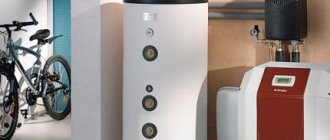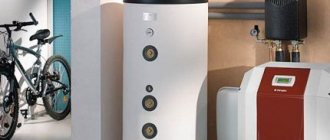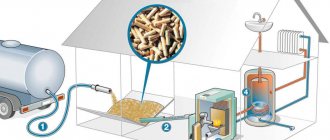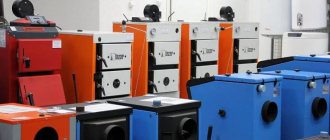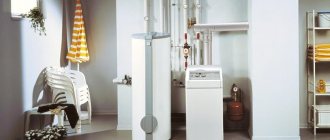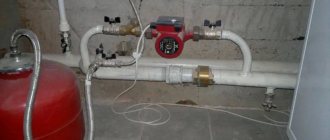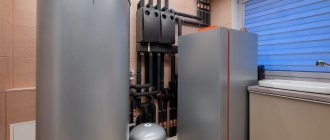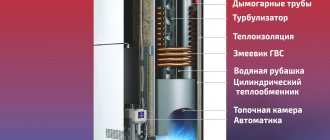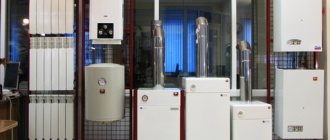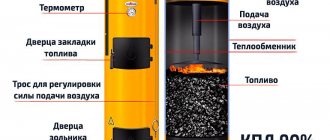Properly choosing boilers for heating a private home is necessary for installing an autonomous system. It is heating equipment that will provide housing with heat and hot water. It will create the microclimate necessary for human habitation. In addition, it will work flawlessly. It is so?
We will tell you how to buy a boiler that will meet your requirements and wishes. We have analyzed all the criteria that you should pay attention to when looking through catalogs of online stores or an assortment of specialized retail outlets. Problems that you may encounter before and after purchase are listed.
Basic criteria for choosing boilers
Hundreds of foreign and domestic manufacturers offer thousands of models of heating equipment. It is not easy for an unprepared buyer to navigate all this variety of products. I want it to be cheaper and the quality to be high.
All heating boilers differ in the type of fuel and are divided into the following categories:
- solid fuel (processing firewood, peat, pellets, coal);
- liquid fuel (units running on diesel fuel);
- gas (regular and condensing);
- electrical (requiring electricity supply);
- universal (using either gas or electricity).
Before choosing an option, it would be a good idea to do a little analysis and find out which energy carrier is profitable to use in your region. Then you need to decide how safe, reliable and comfortable the boiler should be in terms of every penny invested in it.
You need to choose one or another type of heating equipment after first familiarizing yourself with the advantages and disadvantages of each of them.
In order not to make a mistake and not waste your hard-earned money, you need to carefully consider the process of choosing equipment. To do this, it is necessary to take into account a number of nuances that significantly affect the final result.
When choosing a boiler you should:
- understand in detail the advantages and disadvantages of each type of boiler;
- calculate the optimal heating power for your home;
- decide on the number of circuits;
- choose the location where the equipment will subsequently be placed.
The maximum permissible dimensions and weight depend on the future location of the boiler. After all, for a small room it is not advisable to choose a heavy cast iron unit.
The choice of heating equipment must be approached responsibly. This is the only way to buy high-quality equipment that will last for many years.
Comparative table of boilers for a house 200-240 m2
| Name | Homeland of the brand | Number of circuits | Combustion chamber type | Fuel | Power | Efficiency | Price |
| Wall mounted | |||||||
| Protherm Cheetah 23 MOV | Slovakia | double-circuit | open | gas | 23 kW | 90,3 % | 58698 rubles |
| Protherm Cheetah 23 MTV | Slovakia | double-circuit | closed | gas | 23 kW | 93,2 % | 61640 rubles |
| Protherm Jaguar 24 JTV | Slovakia | double-circuit | closed | gas | 24 kW | 90,2% | 46230 rubles |
| BAXI ECO Nova 24 F | Italy | double-circuit | closed | gas | 24 kW | 93% | 43899 rubles |
| BAXI ECO-4S 24 | Italy | double-circuit | open | gas | 24 kW | 91,2% | 43899 rubles |
| BAXI ECO-4S 1.24 F | Italy | single-circuit | closed | gas | 24 kW | 92,9% | 49071 rubles |
| BAXI ECO-4S 24 F | Italy | double-circuit | closed | gas | 24 kW | 92,9% | 52470 rubles |
| BAXI LUNA-3 240i | Italy | double-circuit | open | gas | 24 kW | 91,2% | 66184 rubles |
| BAXI LUNA-3 240 Fi | Italy | double-circuit | closed | gas | 24 kW | 93 % | 73875 rubles |
| BAXI ECO Four 1.24 | Italy | single-circuit | open | gas | 24 kW | 91.2 kW | 48893 rubles |
| BAXI ECO Four 1.24 F | Italy | single-circuit | closed | gas | 24 kW | 92,9% | 55094 rubles |
| BAXI ECO Four 24 | Italy | double-circuit | open | gas | 24 kW | 91,2 % | 55809 rubles |
| BAXI ECO Four 24 F | Italy | double-circuit | closed | gas | 24 kW | 92 % | 62189 rubles |
| Vaillant turboTEC plus VUW 242/5-5 | Germany | double-circuit | closed | gas | 24 kW | 91% | 109342 rubles |
| Vaillant turboTEC plus VU INT 242/5-5 | Germany | single-circuit | closed | gas | 24 kW | 91 % | 98268 rubles |
| Vaillant eloBLOCK VE 21 | Germany | single-circuit | — | electricity | 21 kW | 99% | 72636 rubles |
| Vaillant eloBLOCK VE 24 | Germany | single-circuit | — | electricity | 24 kW | 99% | 74882 rubles |
| Protherm Skat 21 (380 V) | Slovakia | single-circuit | — | electricity | 21 kW | 99,5 % | 66983 rubles |
| Protherm Skat 24 (380 V) | Slovakia | single-circuit | — | electricity | 24 kW | 99,5 % | 68532 rubles |
| Floor-standing | |||||||
| BAXI SLIM 1.230 iN 4E | Italy | single-circuit | open | gas | 23 kW | 90,2 % | 85860 rubles |
| BAXI SLIM 1.230 i 4E | Italy | single-circuit | open | gas | 23 kW | 90,2 % | 103509 rubles |
| BAXI SLIM 1.230 FiN 4E | Italy | single-circuit | closed | gas | 23 kW | 90,2 % | 114063 rubles |
| BAXI SLIM 1.230 Fi 4E | Italy | single-circuit | closed | gas | 23 kW | 90,2 % | 131354 rubles |
| BAXI SLIM 2.230 i 4E | Italy | double-circuit | open | gas | 23 kW | 90,2 % | 164744 rubles |
| Protherm Beaver 30 DLO | Slovakia | single-circuit | open | firewood, coal | 24 kW | 90,2 % | 114375 rubles |
Rules for calculating equipment power
It’s worth remembering right away that the desire to save money on designing a heating system and performing thermal calculations in most cases backfires on the customer. If you think through everything carefully and trust a highly qualified specialist, then the cost of the boiler, radiators and other equipment will be much cheaper.
The power of the heating boiler is selected to calculate the distribution of approximately 0.1 kW per m2 of living space
To approximate the power of heating equipment required to heat a building and provide hot water supply, you can use special design standards.
It is also imperative to take into account:
- the number of people who will live in the house;
- building materials used for housing construction;
- climate zone;
- number of windows and doors;
- number of floors and other factors.
The opinion that the boiler power is selected at the rate of 0.1 kW per square meter is quite common. But thanks to modern building materials and innovative engineering equipment, heat losses can be significantly lower and, accordingly, the performance of heating equipment can be higher.
The best long-burning solid fuel boilers
Stropuva Mini S8 8 kW
Bright solid fuel boiler with a safety valve, power 8 kW. Suitable for heating a room of 80 m2. The fuel burns for up to twenty hours, the temperature is enough for the whole night.
Characteristics:
- type of device - solid fuel boiler;
- type of combustion - long;
- contours - single-circuit;
- power - 8 kW;
- area - 80 m2;
- placement - floor;
- energy independence - yes;
- control - mechanics;
- combustion chamber - open;
- fuel - firewood, wood briquettes;
- safety valve - yes;
- thermometer - yes;
- weight - 145 kg;
- price - 53,000 rubles.
Advantages:
- compactness;
- long burning;
- ease of use;
- reliable handles;
- does not require power supply;
- robust design.
Flaws:
- high price;
- heavy weight;
- it is difficult to wash off carbon deposits from the cladding;
- Not very convenient for loading firewood.
ZOTA Topol-22VK 22 kW
A high-quality solid fuel device with a power of 22 kW, which is enough to heat an area of 220 m2. Convenient loading consists of two sections for storing firewood.
Characteristics:
- appliance - solid fuel boiler;
- contours - single-circuit;
- power - 22 kW;
- placement - floor;
- control - without control panel;
- fuel - coal, coal briquettes, firewood, wood briquettes;
- thermometer - yes;
- weight - 128 kg;
- price - 36,860 rubles.
Advantages:
- various types of fuel;
- long burning;
- economical consumption;
- convenient operation;
- reliable design.
Flaws:
- heavy weight;
- no control panel.
ZOTA Topol-16VK 16 kW
A decent model of a solid fuel boiler with two sections for storing fuel. Designed for heating a small private house or workshop of 160 m2.
Ensures long burning of wood or coal.
Options:
- unit - heating boiler;
- fuel - coal, firewood, coal and wood briquettes;
- power - 16 kW;
- placement - floor;
- control - without control panel;
- Efficiency - 75%;
- thermometer - yes;
- weight - 108 kg;
- cost - 30,100 rubles.
Advantages:
- heats up quickly;
- gives uniform heat;
- quality materials;
- long burning;
- possibility of laying briquettes;
- easy control.
Flaws:
- high price;
- heavy weight;
- no control panel.
ZOTA Topol-32VK 32 kW
Reliable solid fuel unit with a power of up to 32 kW. Capable of heating an area of 320 square meters. It is possible to install an additional heating element and connect external control.
Excellent for a country house, ensures long burning of fuel.
Characteristics:
- type of device - solid fuel boiler;
- number of circuits - one;
- power - 32 kW;
- area - 320 m2;
- installation - floor;
- energy independence - yes;
- control - mechanics;
- Efficiency - 75%;
- fuel - coal, coal briquettes, wood briquettes, firewood;
- thermometer - yes;
- connection of external control - yes;
- weight - 143 kg;
- price - 40,370 rubles.
Advantages:
- fast heating;
- reliable assembly;
- simple controls;
- opportunity to purchase a burner;
- economical fuel consumption;
- stylish design.
Flaws:
- heavy weight;
- high price.
Stropuva S30 30 kW
A full-fledged solid fuel boiler with a power of 30 kW for heating a room of 300 m2. Equipped with thermometer and safety valve.
Made of high quality steel, the material does not become red-hot when the boiler heats up.
The only boiler that continues burning for up to 31 hours.
Characteristics:
- appliance - solid fuel boiler;
- power - 30 kW;
- area - 300 sq.m.;
- placement - floor;
- control - mechanical;
- contours - one;
- non-volatile - yes;
- combustion chamber - open;
- Efficiency - 85%;
- material - steel;
- fuel - firewood, wood briquettes;
- thermometer - yes;
- safety valve - yes;
- weight - 257;
- price - 89,800 rubles.
Advantages:
- long burning;
- uniform heat;
- fast heating;
- quality materials;
- presence of a thermometer;
- economical fuel consumption.
Flaws:
- high price;
- heavy weight;
- bulky.
Features of single- and double-circuit boilers
When thinking about how to choose the right heating boiler for your home, special attention should be paid to such a characteristic as the number of circuits. Single-circuit technology is intended exclusively for heating the coolant circulating through heating pipes.
A single-circuit boiler is designed to serve only one system: either hot water supply or heating. If it is not possible to install a double-circuit unit, it is permissible to use no more than two boilers in one boiler room, regardless of their floor or wall-mounted design
In this case, to heat tap water you will have to additionally install a boiler. Yes, a single-circuit boiler is convenient, but the disadvantage of this solution is its high cost - you will have to buy not only heating equipment, but also a boiler. Moreover, both devices will take up a lot of space.
As for the double-circuit boiler, here the heating equipment and water heater are assembled into a single structure. Thanks to this structure, you can solve two problems at once, while purchasing only one unit.
In addition, in the absence of hot water, the coolant can be redirected to the second circuit and used alternately - to heat the house and to provide hot water supply.
Operating principle of single-circuit equipment
Single-circuit heating equipment is most often used by owners of luxury country houses. In essence, a single-circuit boiler is the same water heater, but supplies water to the heating system.
The operating principle of this type of equipment is based on burning fuel in a special compartment and heating the liquid. The heating main is connected to the outlet where the hot coolant enters. Next, the water begins to circulate through the pipes and heat the rooms.
The final stage of circulation is the flow of waste coolant back into the boiler through the inlet pipeline.
If you do not need to provide hot water supply, then it is better to give preference to single-circuit boilers
The cost of a single-circuit boiler may be more than a double-circuit system. Even despite less functionality, this type of equipment is less expensive to install, easier to operate and more energy efficient.
Single-circuit equipment is suitable for those buyers who want to spend money once and buy reliable equipment that does not require special care. This type of boiler will be the ideal and only right choice when there is no need for hot water supply in the house.
Design specifics of a dual-circuit unit
A double-circuit boiler is a system where, in addition to the primary heat exchanger, there is an additional one designed to heat water and then supply it to the water supply system. The movement of the coolant is controlled using a three-way valve. It directs the heated water either to the DHW circuit or to the heating system.
It should be noted that in the first case, the coolant will be supplied only if the hot water tap has been opened. The peculiarity of such heating equipment is that while the tap responsible for supplying hot water is open, the system does not work.
If you have a large family and some of its members like to take long showers, then the rooms may become cool. Manufacturers solve this problem by installing a storage water heater in their boilers.
The disadvantages of the double-circuit boiler design include the need for careful and attentive maintenance. This is due to the fact that the secondary heat exchanger can become overgrown due to the use of water containing organic and mineral particles suspended in it, and the small diameter of the pipes.
If you plan to actively consume hot water, then installing a double-circuit boiler is not the best solution. After all, then the house will not be heated well. You should only think about installing this system in a small house or apartment, where there is not enough space to organize a full-fledged boiler room.
Types of coolants
Distilled water prevents scale deposits, recommended for closed systems.
For effective heating, the correct coolant must circulate in the system. The liquid must have good heat capacity and heat transfer, as well as chemical inertness. The systems use two types of coolant:
Water
The simplest, cheapest and most accessible way to distribute heat through pipes and radiators is to use water. The liquid is safe in case of leakage. Distilled water does not cause scale on heating elements and sediment in tubes. With many positive qualities, it has disadvantages:
- freezes at temperatures below 0°C, can rupture the pipeline;
- causes metal corrosion;
- preparation is required to exclude salts from the composition.
The use of water is recommended for permanent residences. In other cases, it is better to abandon it in favor of non-freezing compounds.
Antifreeze mixture
Antifreeze does not freeze in the system, it is recommended for heated floors.
Various antifreeze liquids are designated by a common name - antifreeze. Most often, ethylene glycol is used as a coolant. The composition prevents corrosion, scale and freezing of pipes. Its significant disadvantage is toxicity. Safe antifreeze propylene glycol has all the positive characteristics, but is less popular due to its high price.
Varieties of boilers by type of draft: natural draft - created without installing special devices, the advantage is independence from electricity; forced draft with air supply - combustion products are removed and air enters the combustion chamber using fans; forced draft without air supply - special equipment removes gas combustion residues through the chimney.
Selecting a location for heating equipment
All types of heating boilers are produced mainly in a floor-standing version, electric in a wall-mounted version, and gas in both a wall-mounted and a floor-mounted version. The latest variation is best installed in a spacious separate room. Such heating equipment is characterized by great power and massiveness.
A wall-mounted boiler will be an ideal solution for small-sized houses, where every square meter counts
And due to the fact that the weight of floor-standing boilers is not limited in any way, manufacturers install a cast-iron heat exchanger in it, which is much more reliable than a steel one.
Wall-mounted heating equipment is compact in size and fairly light in weight. But this type of boiler is limited in power. This minus is especially relevant for dual-circuit systems - the performance of the heating circuits will be quite low.
You should choose wall-mounted boilers only if the heated area does not exceed 200 m2 and the hot water consumption is no more than 14 l/min. If the needs are greater, then it is better to give preference to the floor-mounted variation of heating equipment.
It should be noted that many buyers, regardless of the size of their living space, prefer floor-mounted systems that are equipped with a cast-iron heat exchanger. After all, such devices are less demanding on the quality of power supply.
Is an open or closed chamber better for a gas boiler?
Atmospheric traditional boilers with an open chamber take air for combustion of gas fuel directly from the room, so they require good ventilation. The combustion products are removed through a classic vertical chimney. These are boilers of simple design, easy to repair and maintain.
A closed combustion chamber is a more modern and technologically advanced option. Such boilers for a 200 m2 cottage use a coaxial (lateral, passing through the wall) chimney to take in air from the street and exhaust smoke. Boilers with a closed chamber have a built-in fan. They are considered the safest to operate, but their cost is higher than that of atmospheric models.
Subtleties of using boilers
The vast majority of boiler models require electricity to function properly. The only exception is solid fuel heating equipment that burns coal or wood. Such devices can work autonomously.
Why is electricity needed? Current is required for the operation of the boiler system automation and its pumps. Therefore, a good solution would be to order an electric generator along with the heating equipment. This solution is especially relevant for those regions where the power is often turned off.
When organizing a boiler room, special attention should be paid to the chimney to ensure proper operation of the equipment and safety during its use
Regardless of the type of boiler used, the manufacturer does everything possible to ensure that the operation of its equipment is as safe as possible.
Therefore, almost any modern model of heating equipment is equipped with the following protection systems:
- a sensor that detects the presence or absence of a flame;
- traction control sensor;
- a device that will stop the operation of the boiler if the pressure in the gas pipeline drops below the permissible level;
- a device that turns off the boiler in the event of a lack of electricity;
- a system that protects equipment from overheating;
- a sensor that stops the operation of heating equipment in the event of a decrease in the volume of coolant.
All the details listed above are the bare minimum that will protect the boiler from breakdowns and the home itself from fire.
As for the location of the equipment, certain models of boilers, the boiler power does not exceed 100 kW, can be installed directly in the kitchen.
Other types of heating equipment must be placed in a specially equipped room of a certain cubic capacity, with a thoughtful and well-designed ventilation system, with fire safety devices, etc.
The organization of a boiler room must be approached with all responsibility and must comply with all recommendations of specialists, as well as fire safety standards
The most commonly used boilers in the CIS countries at present are gas boilers. This demand is explained by the low cost of this energy carrier, as well as the reliability and durability of boilers of this type. But due to regional characteristics, gas heating equipment is not always the most optimal and profitable solution.
You need to choose heating equipment depending on your personal wishes and needs, the size of your living space and the availability of energy.
Economical fuel consumption and reduction in equipment maintenance costs are an important component of choosing the optimal unit for an independent heating system. The rules for organizing energy-saving heating are given in our recommended article.
Types of heating boilers for a private home
The operating principle of all boilers is similar: fuel is burned in the combustion chamber, this heats the heat exchanger, which contains the coolant (usually water), then the water circulates through the system and releases heat through heating radiators. First of all, the classification of hot water heating boilers is made according to the type of fuel used.
Gas
In the photo - wall-mounted dual-circuit gas Buderus Logamax U072-24.
If gas is connected to the house or a gas main is laid near it, you should buy a gas boiler without hesitation. In 2022, this is still the most optimal and most economical solution in Russian conditions. The equipment is relatively inexpensive, the market and its choice are large, natural gas itself is extremely cheap compared to other types of fuel. At the same time, there is no need to worry about the delivery and storage of fuel, and gas boilers can operate for days and weeks without human intervention, stably and accurately maintaining the set temperature.
This option is especially suitable for permanent residence in a house; double-circuit boiler models can provide not only heating, but also the preparation of sanitary hot water for 1-3 points of consumption at a cost that is only 10-15% higher than single-circuit ones.
There are also nuances in the case of gas boilers. The equipment requires registration of technical conditions (permits), compliance with the requirements for the premises, ventilation and chimney. It is necessary to call specialists for scheduled maintenance once every few years (and it is recommended - annually), the cost of the issue is about 500-1,000 rubles. The design, connection and commissioning of a gas boiler will take from 1 to 3 months, but in terms of cheapness and ease of use it is worth it.
Service life: 10-40 years (depending on device and materials).
Cost: from 13,000 rub. for the most budget floor models; the average good boiler is 33,000-38,000 rubles.
Gas heating boilers: the most detailed selection instructions. Checklist by criteria, best models, prices and owner reviews
Electrical
In the photo - a heating element electric boiler Proterm Skat.
Maximum operating comfort, but high energy costs - this is how electric boilers can be described in one sentence. Despite the lower initial cost, the absence of the need for a chimney and ventilation (even permission to install an electric boiler is not required), the cost of heating a house using electricity is the highest. Heating an uninsulated or poorly insulated house with an area of 100 m2 can cost about 15 thousand rubles on average per heating season.
If the budget is limited, an electric boiler is an excellent option only for temporary residence in the house or as a backup boiler unit. As a last resort, the option is suitable for very small private houses with an area of up to 60-70 m2. In such cases, the initially low cost of equipment and its connection will pay off high operating costs for a long time.
To connect a boiler with a power of more than 6 kW, a three-phase (380 V) electrical network is required, since a standard two-phase (220-230 V) simply cannot provide operation at maximum power. Installation of an electric boiler with a power of more than 10 kW requires approval from the Energy Supervision authorities. Otherwise, the electric boiler is a mini-boiler room; it is enough to connect the supply and return lines to it. The safety group, expansion tank, circulation pump and other elements of the heating system are usually already installed. There is no need to service the electric boiler annually; it is enough to clean it from scale once every 3-7 years and change the heating element, the cost of the issue is about 1,000-5,000 rubles.
Service life: 3-7 years without replacing the heating element; 15-30 years with regular replacement of heating elements.
Cost: from 4,000 rub. for the most budget models; the average good boiler is 28,000-41,000 rubles.
How to choose an electric boiler for heating a private home Types of electric boilers, selection criteria, the best models and their cost
Solid fuel
The photo shows a long-burning solid fuel boiler KSP Duo with an automatic feed hopper.
Solid fuel boilers burn coal, wood, pellets, peat, logs and other types of solid fuel to produce heat. The most common reason for choosing a solid fuel boiler is the absence of a gas main near the house, less often - the low cost or availability of solid fuel, for example, in coal-mining regions. Also, solid fuel boilers are still in demand due to their low cost, reliability and energy independence. At the same time, modern models are far from the old-style models in terms of efficiency and operating comfort, even to the point of complete automation of fuel loading.
But this is if we talk about expensive boiler units; budget models have also become more advanced, but still require the work of a fireman: regular refilling of fuel for 3-5 hours, daily cleaning of soot. You also need to organize a place to store fuel, preferably it should be a room. The choice of solid fuel boilers is also huge; long-burning boilers with a burning duration of one fill from 10-15 hours to 2-3 or even 7 days have been especially popular lately. A permit to install a TT boiler is not required.
Service life: 15-40 years (depending on the heat exchanger material).
Cost: from 14,000 rub. for the most budget models; the average good boiler is 25,000-35,000 rubles.
Solid fuel boilers: the most detailed instructions How to choose, review of the best models, their characteristics and prices
Liquid fuel
Diesel Kiturami Turbo and plastic fuel storage tank.
Diesel is supplied using a fuel pump. Liquid fuel means diesel fuel (diesel fuel), waste oil and fuel oil, and kerosene. Liquid fuel boilers are something between solid fuel and gas: they still require space for storing fuel and tanks for it, and are still not completely autonomous due to the need for regular maintenance. At the same time, liquid fuel boilers do not require a large number of documents, on average they have a higher efficiency than their gas counterparts, they are reliable and autonomous.
However, they choose boilers that run on liquid fuel, mainly due to the availability of a stable source for the purchase of this fuel at a lower price (service stations, vehicle fleets, agricultural equipment service centers, etc.). The initial cost of the equipment, with the exception of rare models, is extremely high, which is also the reason for the unpopularity of liquid fuel boilers. In addition, the burners in such boilers are very noisy, and during operation they produce a specific smell; high-quality ventilation is necessary.
Service life: 20-40 years.
Cost: from 35,000 rub. for the most budget models (there are only a few of them on the market); the average good boiler is 75,000-100,000 rubles.
Features of operation and types of liquid fuel boilers Selection criteria, best models, prices and owner reviews
Combined
Combined model with an installed gas burner.
Diagram based on the example of the Teplodar Kupper OK 15 model. These are universal boilers that operate on several of the types of fuel listed above - an excellent option if you haven’t been able to decide on fuel or if a temporary solution is needed, for example, before laying a gas main near your house. There are 5 main types of universal heating boilers:
- gas-wood;
- on wood and electricity;
- on gas and electricity;
- on gas and liquid fuel;
- multi-fuel, operating on 3 or more types of fuel.
The transition from one type of fuel to another in combination boilers is carried out by simply switching or simply replacing a quick-release burner. For example, using a model with wood and electricity, you can burn logs during the day, and at night switch the boiler to a heating element built into the heat exchanger, which will maintain a satisfactory temperature in the house until the morning. Particular savings can be achieved if a multi-tariff electricity meter is installed.
The disadvantage of such designs is the lower efficiency when burning any type of fuel, a higher price compared to two single-fuel boilers, and a small selection on the Russian market.
Service life: 10-25 years.
Cost: from 20,000 rub. for the most budget models; the average good boiler is 50,000-75,000 rubles.
Combination boilers for heating a private home Types, selection criteria, best models and prices
Device material
When choosing raw materials for the production of devices, their operation at elevated temperatures is taken into account.
Cast iron
The material is used for the manufacture of all boiler options.
Advantages:
- long service life - up to 50 years;
- resistance to scale deposits;
- easy to care for, without the use of chemical-based detergents.
Flaws:
- high inertia;
- heavy equipment weight;
- immunity to sudden temperature changes;
- low efficiency;
- fragility.
At the same time, cast iron appliances look quite large and have a high price.
Combination cast iron boiler.
Steel
Metal appliances are in great demand among consumers.
Advantages:
- high operating efficiency of the loading chamber - autonomy;
- much cheaper than cast iron analogues;
- high resistance of steel to temperature changes;
- ease of construction;
- low inertia;
- plasticity of the material;
- increased resistance to mechanical loads;
- high efficiency;
- maintainability and ease of maintenance.
Flaws:
- the maximum operational period is 25 years;
- scale quickly forms in metal heat exchangers;
- have low corrosion resistance.
When choosing metal boilers, you need to install insulated stainless steel chimneys in the building.
Steel heating boiler.
Ionic
Electrode devices operate without additional reservoirs and are connected directly to bimetallic or aluminum radiators. The material contains impurities that significantly impair the functionality of the device.
How to calculate the boiler power?
The simplest and roughest way to calculate the required boiler power is to provide 1 kW of power per 10 square meters of area. Such calculations are suitable for typical houses with standard windows.
More accurate figures can be obtained if you first calculate the heat loss of the house. The Internet is full of similar calculators. An ordinary computer user can do the calculations. For the calculation you will need the following data:
- Room sizes
- Thickness of internal and external walls
- Wall material
- Ceiling height
- Window sizes
- Insulation details
- Maximum calculated subzero temperature
By entering all this data, you will receive the amount of heat loss in kilowatts. The quantity will be equal to the required boiler power.
It should be noted that boilers for heating a house need to be selected with a reserve:
- Electric and gas with a 10% reserve
- Solid fuel with 30% reserve
Solid fuel boilers are highly dependent on the quality of the fuel. Therefore, the efficiency of the boiler may vary.
It is also worth considering the presence of an indirect heating boiler. It also requires separate power.
Classification by functionality
Heating boilers are single- and double-circuit. They differ in their functionality.
Single-circuit
The main purpose of these models is heating residential premises.
Operating principle: heating water in a container to the required temperature, supplying hot liquid to radiators (batteries) located in the rooms of the building.
Advantages:
- minimal raw material costs;
- significant savings during operation.
The main disadvantage is expensive equipment.
There are different models on the market that can operate on gas, solid and liquid fuels, and electricity.
Dual-circuit
Devices of 2-phase design simultaneously perform several functions:
- equipping the house with warm water;
- heating of residential premises.
A distinctive feature of the design is the presence of 2 separate heat exchangers with a closed and open fluid supply system. In the first case, it is used only for heating the building. In the second, water is additionally heated for domestic needs.
Double-circuit gas boiler.
Compactness and dimensions
Electric boilers take first place in size and ease of placement.
Options:
- minimum length – 30 cm;
- weight – from 0.5 to 11 kg.
Their dimensions depend on the number of heat exchangers used and their sizes. Such devices are capable of heating rooms with an area of 40 to 250 m².
Single-circuit design models without a boiler are most often used in city apartments. The compact dimensions of floor-standing solid fuel boilers are characteristic of pellet products. In large private houses, double-circuit devices are installed.
Dimensions depend on the size of the fuel loading hopper. The smallest one is for 2 buckets. This amount of raw materials is enough for 1 day.
To heat large areas, large floor structures are used.
Combination boilers. Are they worth using?
Combination boilers, or otherwise universal ones, are most often found of the homemade type. Factories rarely resort to a combination of one or another boiler. The only thing you can find are solid fuel boilers with the possibility of inserting electric heating elements.
We do not recommend that you use combi boilers. You won't be able to save money on heating your home. If there are small costs now, they will certainly arise during operation.
Each boiler has its own device and operating principle. When combining one solution with another, you always have to sacrifice something. A universal boiler is a sure way to high heating costs.
